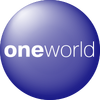| 1973–1984 | ||
| 1973–1984 | 1984–1997 | 1997–present |
1973–1984
| SVG NEEDED |
British Airways was formed in 1973 through the merger of BOAC and British European Airways. However, BOAC and BEA had already started phasing in the new identity by then. The logo, identity and livery was created by Negus & Negus and presented in 1973. Also part of the identity was a part of the Union jack that could be found a the tailfin of the planes. As a result of pressure from BOAC employees, the speedbird that was part of BOAC's identity was retained and put at the front of the planes.
1984–1997
On December 4, 1984, British Airways revealed a new identity and livery, created by Landor Associates.[2][3] The choice of Landor sparked some controversy in the British design community, as it was unusual at the time for British companies to contract foreign agencies for design work.[4] Perhaps in an effort to stem criticism, British Airways' press release made sure to mention that other aspects of the rebrand would be handled by British companies, naming suppliers of paints, signs and stationery before mentioning Landor.
The new livery featured three colours, which were called pearl grey, midnight blue and brilliant red. Many aspects of the Negus livery were kept. Although the shades were different, the lower part of the fuselage remained blue and the upper part had a slight colour change from white to "pearl grey". The part of the Union Jack that was on the lower part of the tailfin was also retained, while the upper part of the tailfin was changed to blue and emblazoned with British Airways' coat of arms. The font of the name was also changed.
The most distinctive change was the addition of the red "Speedwing" which runs along the entire fuselage. The Speedwing could also be seen in the airline's new logo.
1997–present
British Airways unveiled a new identity on June 10, 1997. This was an attempt rid themselves of a stuffy overly British image and become a truly worldwide airline. The new identity was developed with Newell & Sorrell.
A new ribbon symbol was developed, which would sit prominently at the front of the fuselage. It was called the "Speedmarque", hinting it link back to the old BOAC speedbird symbol. The typeface for the name became slightly "softer", but still retained similarities with its predecessor. The amount of blue on the fuselage was reduced in favour of more white. The shades of white and blue became brighter.
The most significant part of the multicultural identity was that the airline allowed artists from all over the world to repaint the entire tail with motifs the from the airline's diffrent destinations. When the "World Images" liveries were launched there were fifteen different tails designs. The original plans were to have up 50 different designs.
The tails proved controversial, and in a few years the airline switched to a design with the Union Jack for all planes.
External links
| Current members Alaska Airlines | American Airlines | British Airways | Cathay Pacific | Finnair | Iberia | Japan Airlines | Malaysia Airlines | Qantas | Qatar Airways | Royal Air Maroc | Royal Jordanian | SriLankan Airlines Upcoming members: Oman Air | Hawaiian Airlines Suspended members Affiliate members Former members Former affiliate |
| Divisions Aer Lingus | British Airways (Comair) | IAG Cargo | Iberia | Level | Vueling
Subsidiaries Defunct |


